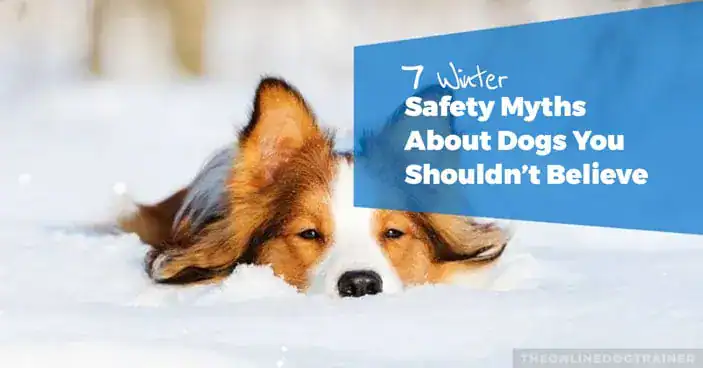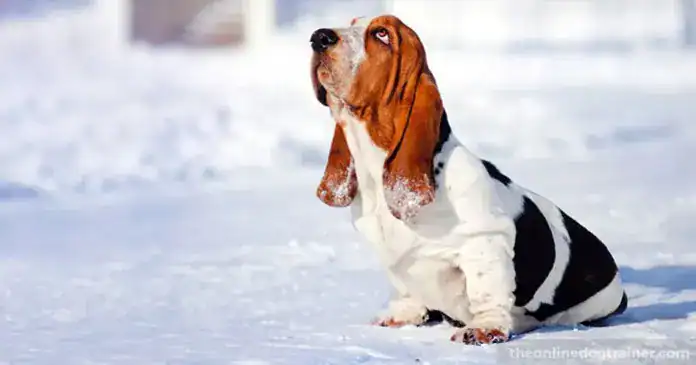Are you giving the right winter care for your dogs? These myths are causing more harm than good, so it’s best to know them right now.

During the summer months, there’s a lot of talk about the dangers of leaving your dogs out in the summer heat.
However, once winter rolls around, people don’t seem to be as concerned about the temperatures.
Of course, it’s common for people to remind dog owners to bring their pups indoors overnight when the weather drops below freezing. But, other than that, there’s not much to worry about, right?
Wrong.
Sadly, there are a lot of myths about winter weather and dog safety, so today I want to talk about 10 things you simply shouldn’t believe in order to keep your dog safe.
Have you mistakenly believed any of the following myths?
Find out now…
FREE REACTIVITY WEBINAR: LEARN HOW TO BRING BACK CALM TO YOUR DOGKey Takeaways:
- Many dogs lack the fur to withstand winter. Shelter is crucial even for cold-weather breeds.
- Fleas and ticks survive indoors year-round, posing a risk even in winter.
- Dog paws are vulnerable to cold and ice. Booties are recommended for long snowy walks.
Table of Contents:
Myth #1 – Fur Protects All Dogs from Cold Weather
All dogs originate from wild dogs. And wild dogs don’t have homes to keep warm in during the winter.
Therefore, all dogs have good enough fur coats to safely stay warm in the winter, right?
The answer is no.
Our dogs’ ancestors were equipped to live in cold-weather climates. And some dogs (such as huskies) are still genetically designed to have fur coats that will keep them warm in harsh climates.
That being said, a large majority of the pet dogs we have now have been bred to have less hair and simply can’t thrive in cold weather anymore.
Some dogs, such as Brittany Spaniels or Chihuahuas, don’t even have a double coat anymore. This puts them at high risk for getting ill or even dying if they are left out in the cold for too long.
If you have a dog that you plan on leaving outside full-time during the winter, you better make sure he is a breed that is designed for cold weather.
Furthermore, even if your dog has the right fur type to live outside in the cold, it’s vital that you provide your pup with a doghouse or some form of shelter he can use to get out of the rain, snow, and wind.
In the wild, a warm den protects wild dogs from freezing to death. Your pup needs the same setup to ensure his safety.
LEARN WHAT REALLY CAUSES REACTIVITY: JOIN THIS WEBCLASS FOR FREEMyth #2 – Dogs Can’t Get Fleas/Ticks in the Winter

A shocking number of people stop using flea and tick meds in the winter to save some money.
After all, it makes sense as most bugs die in the winter, right?
Sadly, this is a very common misconception. In fact, as the temperatures start to drop, bugs often seek refuge in your home to stay warm. And, whether you realize it or not, they can still be lurking around your home, looking for a food source—a.k.a. your dog.
Yes, the likelihood that your dog will get fleas or ticks certainly drops during the winter.
To ensure your dog doesn’t end up sick due to ticks and fleas, I recommend you keep an eye on your dog year-round.
If you have reservations about the treatment and want to minimize the usage or save money, then I understand. That's why I fully recommend you consider using a flea bomb. These bombs will actually kill the flea eggs that are not on your dog and will break the cycle, meaning that you are safe from fleas for longer.
LEARN DOGGY DAN'S LIFECHANGING TRAINING TIPS FOR FREEMyth #3 – Dogs Don’t Need Paw Protection for Walks in the Snow
Before we leave the house, we put on shoes. The reason: We need to protect our feet.
However, we don’t often give much thought to our pups’ feet when we take our dogs out of the house because their paws are designed to go barefoot.
For this reason, the idea of putting boots on your dog when it snows might not ever cross your mind.
And, honestly, is it really even necessary?
The answer is yes and no.
Think of it like this…
In the winter, people wear gloves to keep their fingers from getting cold. So if you’re out for a long walk or to play in the snow, you’d put your gloves on to keep your hands warm and safe.
On the flip side, if you’re simply running out for a minute to grab the mail, you probably wouldn’t put gloves on because your hands won’t be exposed to the cold for long.
The same logic applies to dog breeds that aren’t designed to go out in the snow.
If you’re letting your dog out to go pee, it’s probably not necessary for you to protect his feet.
However, if you’re taking your dog on a long walk through the woods and the ground is snowy and cold, doggy boots are important.
While dogs have tough paw pads, some are susceptible to frostbite and should be protected just like you’d wear gloves to protect your fingers.
If your dog spends a lot of time outside in the snow but isn’t built for cold weather, it might be a good idea to invest in a pair of dog booties. You can find them in any pet store!
Myth #4 – It’s Safe for Dogs to Eat Snow

Snow is just solidified rain water, so it’s totally safe for your dog to eat it, right?
The answer to this question really depends on where you live.
If you live in the suburbs or city, it can actually be very dangerous for your dog to eat snow.
The reason: Snow plows and ice trucks often dump dangerous chemicals on the roads to keep them from icing over. These chemicals can then spill over into the snow and make your dog extremely sick if he ingests it.
If you live out in the country where the roads aren’t treated with chemicals, then it’s typically safe for your dog to eat the snow. Just ensure it’s clean snow and there’s no trash hidden in it!
And don’t forget…moderation is key!
In a nutshell…be aware of your surroundings, and use your best judgment. A bowl of clean water is always the best and safest option for your pup.
If your dog really loves eating frozen treats, spoil him with one of these popsicle recipes.
Myth #5 – You Can Leave Your Dog in a Car during the Winter Because It’s Not Hot
Last but not least, a lot of people think it’s okay to leave a dog in a car during the winter months because it’s no longer hot outside.
There are a few flaws in that logic.
First, just because it’s not hot out doesn’t mean that the sun isn’t hot.
All cars are like little mini-greenhouses. As the day goes on, the sun has the power to warm your car up. And depending on the outside temperature, the solar heat in your car can definitely reach temps that aren’t safe for your pup.
Second, it’s possible that it could get too cold in your car—especially on a cloudy day.
If your heat is not running and you leave your dog out in your car for too long, he might get dangerously cold.
Finally, cars aren’t always the safest places for dogs, regardless of the temperature. For example, someone could easily steal your pup from your car, or your dog could get into something that could hurt him when left alone.
If you’re running a quick errand like dropping a check off at the bank, then your pup should be fine in your car. However, if you’re going to be away from your dog for more than 15 minutes or if you are going to be parked in the full sunshine, it’s best to just leave your dog at home.
Myth #6 – Dogs Can Be Left Outdoors As Long As They Are in a Kennel
Leaving your dog outside without protection is bad. But leaving a dog outside in freezing weather with access to a kennel is okay, right?
Well…the answer is sort of yes and no.
There are some thick-coated dogs, such as huskies, that can be left outside as long as they have a place where they can get out of the rain/wind/snow.
However, there are also tons of other breeds—like Chihuahuas or Labs—that just don’t have the right coat types for staying warm in freezing temperatures.
Also, do your research, and talk to your vet before leaving your dog outside overnight—even if you have a kennel.
Myth #7 – Dogs Only Need a Blanket on the Floor to Stay Warm and Comfortable
Yes, there are some dogs that have thick coats and prefer sleeping on hard, cold surfaces such as hardwood floors or tile.
However, many—if not most—dogs would prefer a comfy, cozy dog bed.
Why?
First, a thick dog bed can help keep a dog warm and cozy on freezing days.
Second, much like humans, cold weather can cause a dog's joint pain to flare up or make a dog more stiff. For this reason, it’s nice to give a dog the option to lay somewhere soft and warm up.
Personally, my dogs love cozying up with a warm alpaca blanket.
Take a peek below at where my dogs sleep!
While a blanket is better than nothing, a dog bed is always a nice treat for dogs who want to stay warm and cozy in the winter—especially if you don't let your dog on the furniture.
JOIN OUR FREE CLASS TO TRAIN BETTER BEFORE IT'S TOO LATEMyth #8: Dogs Don’t Need Hydration in Cold Weather
This myth likely stems from the fact that dogs may seem less thirsty in cold weather. We, as humans, often feel less thirsty when it's cold, and project that onto our pets. Also, the air is often drier in winter, and dogs may lose fluids through respiration without appearing to pant as much as they do in the summer heat.
Dehydration is just as dangerous in winter as it is in summer. Dogs still lose fluids through respiration, urination, and even panting (though it may be less noticeable). Dry winter air can exacerbate fluid loss. Dehydration can lead to various health problems, including kidney issues, decreased energy levels, and constipation.
Ensure your dog always has access to fresh, clean water, even when it's cold. Monitor their water intake and offer water more frequently than you might think necessary. Consider using a heated water bowl to prevent freezing.
FREE WEBINAR: FINALLY ADDRESS DOG REACTIVITY ISSUES FOR GOODMyth #9: All Dogs Love Playing in the Snow
We see happy dogs in snow and assume all dogs enjoy it. Some breeds, especially those from cold climates, do, but this isn't universal. We also tend to project our own enjoyment of winter onto our dogs.
Not all dogs enjoy snow. Forcing a dog to stay outside in the cold can lead to hypothermia, frostbite, and discomfort. Small breeds, short-haired dogs, seniors, and puppies are especially vulnerable. Even thick-coated dogs can get cold with prolonged exposure.
Watch your dog's behavior. Do they play joyfully, or do they shiver, lift their paws, or try to go inside? Limit time outside in extreme cold and provide a warm retreat. Consider booties for paw protection. If you're cold, your dog probably is too.
Myth #10: Coats are Only for Small Dogs
People often think larger dogs have enough fur and body mass to stay warm, and that only small dogs need coats. All dogs can get cold, regardless of size. Short-haired breeds, thin dogs, seniors, puppies, and dogs with health conditions benefit from coats. Even thick-coated dogs can get cold in prolonged exposure to freezing temperatures. Shivering is a clear sign a dog is cold.
Consider a coat for any dog in cold weather, especially those in vulnerable categories. A coat helps retain body heat. Look for waterproof/resistant outer layers and warm linings. Monitor your dog for signs of discomfort, even with a coat, and limit time outside in extreme cold.
Not sure if your dog is having a hard time with the cold or not?
I put together a FREE guide to help dog owners out this winter and to keep dogs safe.
↓Download my FREE guide “3 Signs Your Dog Is Too Cold” here↓

So, how did you do? Have you ever fallen for one of the common winter myths above?
Let me know in the comments below!
Oh, and if you know any other myths that we didn’t talk about in this blog, I’d love to hear about them. Leave your myth for me to read in the comments below as well.
Well…I hope you learned a thing or two today that will help keep your dog safe and warm this season.
Enjoy the snow,

~Doggy Dan 🙂







6 Responses
good stuff DAN I knew about the fleas but the tick’s I’m not to sure about I thought they died off in the winter.Will keep a closer eye out for them.Thanks for all the tips you have been a big help to me.Now what about eating grass?
Glad you found my Blog informative Shirley! It’s always best to check with your local Vet about the habits of ticks native to your area, just to be safe. As far as dogs eating grass there are many reasons they do this. Some dogs eat grass when they have an upset stomach and some dogs eat grass to gain important nutrients…..especially fresh, green grass. It’s not something to be concerned about unless it’s followed by a lot of vomiting which occurs over a longer period of time. A trip to the Vet would then be recommended to ensure your dog is in fine health. Best, Doggy Dan
Good stuff Dan, most informative
Thanks James! Glad you found my Blog helpful…Best, Doggy Dan
Great post Doggy Dan, thank you! I live in Canada and something that we see a lot is salt and other chemical de-icers put on sidewalks and roads. So if you don’t put bootees on your dog please please make sure that you give your dogs paws a good wash when you get home to get those chemicals off and the salt out from between their toes and dry it well so it doesn’t stay wet and so they don’t lick them. Another point is that most animals huddle together with other animals for warmth. A single dog is at a great disadvantage without another animal to share heat with.
Hi Lisa…. thanks for your really helpful advice in regards to washing the salt and de-icers from a dog’s feet after being exposed to areas that may have those products used on them. I’m sure many dog owners wouldn’t even be aware of this being an issue. Best, Doggy Dan